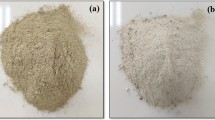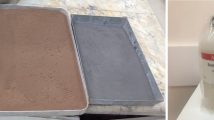Abstract
The aim of this research is to study the additive effect of fumed silica waste on some physical and mechanical properties of clay bricks. Ts perform that, five batches of Egyptian clay and fumed silica were designed with fumed silica ratio 0, 2, 4, 6 and 8 mass-%, shaped into a cylinder mould and fired at 800°C, 900°C and 1000°C. The chemical and mineral composition of the raw materials was carried out using XRF and XRD as well as SEM and EDAX, respectively. Phase composition, physical and mechanical properties of fired batched were investigated to evaluate the changes occurred as a result of fumed silica addition and firing. We concluded that addition of fumed silica leads to; reduce density, shrinkage and compressive strength, while the water absorption and porosity increased. The rising of the firing temperature leads to increase density and compressive strength as well as the linear shrinkage, while reducing the porosity and water absorption. All samples have sufficient strength values greater than 20 MPa. These results confirm that the brick samples produced from fumed silica addition with clay with different ratio could be used as a construction material.
Similar content being viewed by others
References
Grim, R.E.: Applied Clay Mineralogy. McGraw-Hill, New York (1962) 402
Grim, R.E.: Clay Mineralogy, 2nd edition. McGraw-Hill, New York (1968) 596
Harvey, C.C., Murray, H.H.: Industrial clays in the 21st century: A perspective of exploration, technology and utilization. Appl. Clay Sci. 11 (1997) 285–310
Murray, H.H.: Clays. In: Ullmann’s Encyclopedia of Industial Chemistry, Vol. A7. Verlag Chemie, Weinheim (1986) 109–136
Murray, H.H.: Applied clay mineralogy today and tomorrow. Clay Minerals 34 (1999) 39–49
Murray, H.H.: Traditional and new applications for kaolin, smectite, and palygorskite: A general overview. Appl. Clay Sci. 17 (2000) 207–221
Murray, H.H.: Applied clay mineralogy: occurrences processing and application of kaolins, bentonites, palygorskite-sepiolite, and common clay. Development in Clay Science. Elsevier, Amsterdam (2007)
Lagaly, G., Fahn, R.: Tone und Tonminerale. In: Ullmann’s Encyclopedia of Technical Chemistry, 4th ed., Vol. 23. Verlag Chemie, Weinheim (1983) 311–326
Harvey, C.C., Lagaly, G.: Conventional applications. In: Bergaya, F., Theng, B.K.G., Lagaly, G. (Eds.): Handbook of Clay Science. Developments in Clay Science, Vol. 1. Elsevier, Amsterdam (2006) 499–540
Karaman, S., Gunal, H., Ersahin, H.S.: Assesment of clay bricks compressive strength using quantitative values of colour components. Construction and Building Mater. 20 (2006) 348–354
Jordan, M.M., Boix, A.T., Sanfeliu, C., De la Fuenta, C.: Firing transformation of cretaceous clays used in the manufacturing of ceramic tiles. Appl. Clay Sci. 14 (1999) 225–234
Beamish, A., Donovan, W.: Village-level brickmaking. A Publication of Deutsches Zentrum fur Enwicklunstechnologien-Gate. In: Deutsche Gesellschaft für Technische Zusammenarbeit (GTZ) GmbH (1993)
Khan, M.A.: Brief summary of ceramic stains, test methods and applications. Int. Ceram Rev. 47 (1998) [5] 299–302
Domínguez, E.A., Ullmann, R.: Ecological bricks made with clays and steel dust pollutants. Appl Clay Sci. 11 (1996) 237–249
Wiebusch, B., Seyfried, C.F.: Utilization of sewage sludge ashes in the brick and tile industry. Water Sci. Technol. 36 (1997) 251–258
Lin, K.L.: Feasibility study of using brick made from municipal solid waste incinerator fly ash slag. J. Hazard Mater. B 137 (2006) 1810–1816
Yang, J., Liu, W., Lili, Z., Xiao, B.: Preparation of Load-Bearing Materials from Autoclaved Phosphogypsum. Construction and Building Materials 23 (2009) 687–693
Topçu, I.B., Canbaz, M.: Effect of different fibers on the mechanical properties of concrete containing fly ash. Constr. Build. Mater. 21 (2007) 1486–1491
Demirboga, R.: Thermal conductivity and compressive strength of concrete incorporation with mineral admixtures. Build Environ 42 (2007) 2467–2471
Said, R. (Ed.): The geology of Egypt., 2nd edition. A.A. Balkema publishers, Rotterdam, Netherlands (1962)
Brown, M.E., Gallagher, P.K.: Handbook of thermal analysis and calometry. Elsevier, Vol. 2 (2003).
T.S. EN771-1: Specification for masonry units — Part 1: Clay masonry units, (2005)
Author information
Authors and Affiliations
Corresponding author
Rights and permissions
About this article
Cite this article
Elmaghraby, M.S., Ismail, A.I.M. Effect of Silica Fume Addition and Firing Temperature on Physico-Mechanical Properties of Clay Bricks. Interceram. - Int. Ceram. Rev. 65, 166–172 (2016). https://doi.org/10.1007/BF03401165
Received:
Published:
Issue Date:
DOI: https://doi.org/10.1007/BF03401165




